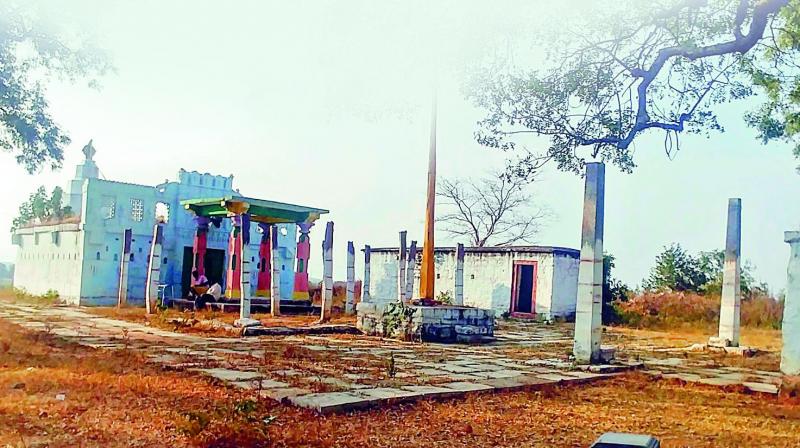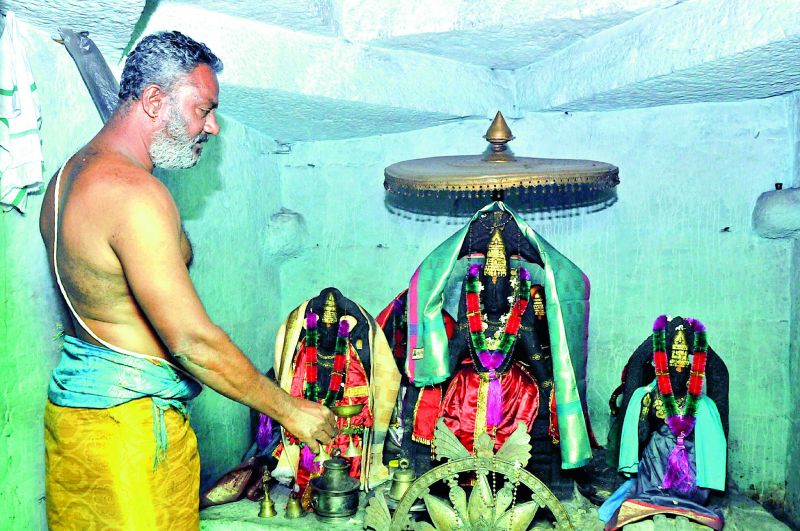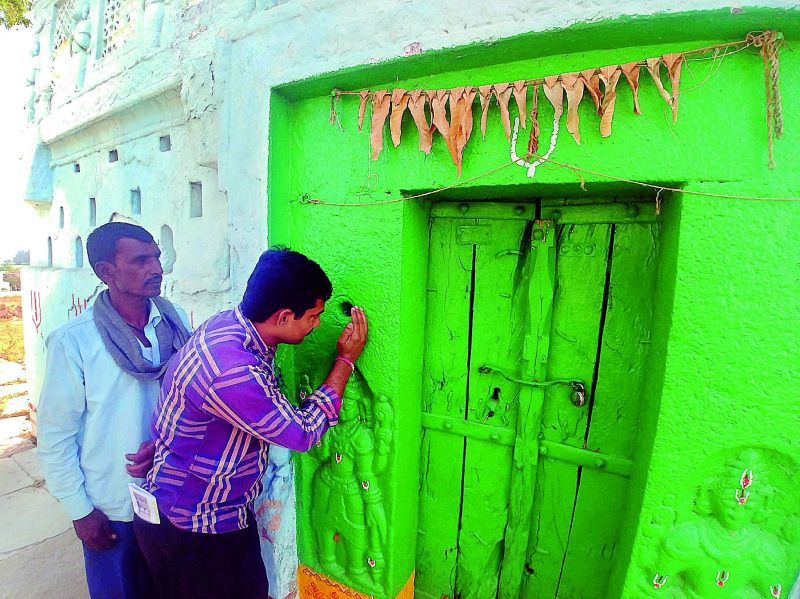Sri Kalyana Ramachandra Swamy temple: Small wonder on a hillock

Hyderabad: Sri Kalyana Ramachandra Swamy temple stands tall and is supported by a tiny hillock. The small temple has a long history and is located in Gummadidala village in Jinnaram mandal of Medak district, 40 km from Hyderabad.
A few facts about the temple should pique pilgrims. Hanuman — the eternal worshipper of Lord Rama — does not find a place in the temple. There are various reasons cited for this. The temple has idols of Lord Rama and Sita along with his brothers and their consorts.
“I am not sure. Maybe this is the only temple in India where the four divine couples reside together,” says Kandadai Vijaya Raman, a 15th generation priest of this unique temple.
 The temple priest performs puja for the deities made in black stone in the sanctum sanctorum.
The temple priest performs puja for the deities made in black stone in the sanctum sanctorum.
The moola murtis of Lord Rama and Sita and the other couples have makara toranalus or prabhavalis. All idols and toranalus are made of black stone, save Shruthi Keerthi, wife of Shatrughana. Her statue was reported to have been destroyed in the attack by the Veera Shaivas, Raman says, who heard about it from his forefathers.
While Lord Rama and Sita stand in the front, Lakshmana occupies a place by Lord Rama with a bow and an arrow. His wife, Urmila, is behind him. Bharatha stands behind Lord Rama with a chamaram, a fan made of animal hair, and his wife, Mandavi, is next to him. Shatrughna stands with an umbrella and next to him is Shruthi Keerthi, made of another material. Her broken statue was kept under the stambha outside the temple which changed about 15 years ago. The old stambha made of rock is damaged and a wooden one is kept in its place.
 A peek of the Lord: A hole built on the door jamb so, devotees can view Lord Rama from outside when the temple doors are closed.
A peek of the Lord: A hole built on the door jamb so, devotees can view Lord Rama from outside when the temple doors are closed.
“I have been doing research and found that this is an 11th century temple and was renovated only once 400 years ago,” says Raman. Four villages, including Seetapuram, Mannegudem, Merugiripeta and Pati, got together and since it was a gathering of people from various parts it was called Ummadidala, which was later known as Gummadidala.
Though Raman insisted that the temple was destroyed only by the Veera Shaivas, there could also have been a Moghul connection to the attack.
“History says that the Donti Samasthanam then had a Venugopalaswamy temple and to conduct pujas for the idols, priests were brought from Sholangipuram in Tamil Nadu,” says Raman.
Several generations worked for this temple, when one individual decided to start his own worship and thus came Raman’s relative to this temple, which was already in place.
While the temple’s uniqueness is quite obvious, there is no koneru or temple pond in the vicinity. While it may have existed earlier, there are no signs of it now. Currently, there is no water anywhere near the temple. For pujas the priest carries water with him every day. There is only one puja every day in the morning.
While the temple is tidy and clean, the outside is strewn leaves. Rama Navami is celebrated with great pomp and the temple gets a brush stroke of ‘dangu chunam’ or limestone coverage.
The temple’s gopuram is built in a tiered structure and the chakra atop the gopuram is made of stone.
A flat roof covers the temple with a small sanctum sanctorum, which the priest says could have been to keep the utsava murtis, which have been shifted to another Lord Venketeswara temple in the same village. Now this sanctum has the moola murtis.
The sanctum sanctorum is bereft of any embellishments, though 12 Alwars sit outside the main sanctum, with Jeeyar Swamy talking to them.
Luckily, the temple has a door which can be locked and there are two brightly coloured dwara palikas outside. Keeping this in mind, Raman says that this temple must have been only for the Vaishnavites, where the men would have to be shirtless — a tradition not followed now. There is also a neat little hole built on the door jamb so you can get a view of Lord Rama even from outside.
An old mandapam stands outside, rock solid, while a small kitchen and yagna shalla stand close to the temple and are not in use. A wooden ratham is located in another building. This was built in 1960 to replace the old one.
“This is a binha devalayam, or one that is destroyed. The Veera Shaiva community luckily did not do too much damage,” says Raman.
There is also talk in the village that instead of developing the already existing temple, they want to raze it to the ground and build a new one, which Raman does not favour. His argument being “my ancestors worshipped here and I have been here for the past 15 years. If they want to build a new temple, they will have to get a new priest.”
He and his family members visited the archaeology department in 2012, which in its notification clearly says that this temple sitting on six acres and 30 cents of land is “described in the schedule here under to be of archaeological and historical importance.”
And goes on to add that “The (then) government of Andhra Pradesh is of the opinion that the said ancient temple requires protection under the provisions of the AP Ancient and Historical Monuments and Archaeological Sites and Remains Act, 1960, and proposes to declare it to be a protected monument.”
Raman does not know what happened after that, but his struggle continues and he keeps working to protect this piece of history. The outside of the temple has Hanuman and Garuda, just over the main door along with a number of monkeys. Incidentally, there is also a small rectangular-shaped Hanuman outside the temple.
There are small sculptures of Krishna in the Kalinga Mardhana pose holding the Goverdhana Giri. The entire temple is built of stone. There are also small jharokhas on the facade of the temple and this could be some Rajasthani influence, when it was renovated 400 years ago.
While Raman’s grandfather Krishnamachari was the priest at the temple, his father Sundaracharyalu was a retired lecturer from the Telugu Oriental College. Raman’s two brothers live in Hyderabad and his son has completed his B Tech in metallurgy. His two uncles look after the other Lord Venketeswara temple. “We get together during Rama Navami,” says Raman happily.
His wish is that there should be more bhakts for the temple to flourish.

